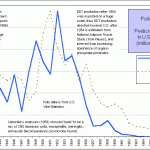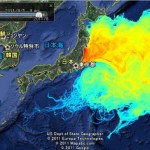radiation
Don't let their small size fool you. Tardigrades, or 'water bears', are really tough animals. According to a review published in the American Scientist, these microscopic invertebrates can survive extreme variations in temperature from near absolute zero (-459 deg F) up to +302 deg F. They can also tolerate pressures that are 6 times greater than the deepest ocean, exposure to ionizing radiation (UV and x-ray) and the vacuum of space, as well as exposure to carbon dioxide and monoxide, nitrogen and sulfur dioxide. What's more, they can survive nearly…
At In These Times, reporter Joseph Sorrentino writes about the heartbreaking plight of uranium miners and millers as well as the history of uranium mining oversight and regulation. He spent a week interviewing uranium workers and their families in New Mexico — workers who are among the thousands who began working in the mines after 1971 and who don’t qualify for federal compensation under the Radiation Exposure Compensation Act (RECA). Sorrentino writes:
Cipriano Lucero worked in uranium mills from 1977 to 1982. He has pulmonary fibrosis, and one of his kidneys failed when he was 48,…
"To be is to be the value of a variable." -Willard Van Orman Quine
It's the end of the week once again, and the very end of our Year In Space 2014 Wall Calendar giveaway! So for this week's Ask Ethan column, after dipping into our question/suggestion box, I'm very pleased to let Vera from Italy know that her question was the winning one, as she asked:
I saw the video you posted about the variable star RS Puppis, by the Hubble Space Telescope, and I really would like a post about what exactly are variable stars.
Thank you very much Ethan!! :-)
So -- no burying the lede here -- there was…
"Twinkle, twinkle, quasi-star
Biggest puzzle from afar
How unlike the other ones
Brighter than a billion suns
Twinkle, twinkle, quasi-star
How I wonder what you are." -George Gamow
The Big Bang is one of the greatest, revolutionary ideas in all of modern science, but it's also one of the most successful ideas as far as making predictions that have aligned with our observations of the Universe. Despite all of that, there are a whole bunch of people who'll read this (and more who won't) who aren't sure that the Big Bang is correct. Some people, in fact, don't even understand the definition…
"The mind, once expanded to the dimensions of larger ideas, never returns to its original size." -Oliver Wendell Holmes
When General Relativity supplanted Newton's work as our theory of how gravity works in the Universe, it didn't just change how we view how masses attract, it gave us a new understanding of what the questions where and when actually mean. It gave us the very fabric of spacetime.
Image credit: Christopher Vitale of http://networkologies.wordpress.com/.
What this meant is that no longer could we view objects like matter and radiation as existing in some fixed, grid…
"According to the special theory of relativity nothing can travel faster than light, so that if light cannot escape, nothing else can either. The result would be a black hole: a region of space-time from which it is not possible to escape to infinity." -Stephen Hawking
You may have encountered objects that are the same size as one another, but have very different masses.
Image credit: Basic Science Supplies / © Accelerate Media.
This is because they're made out of different elements. The higher you go in the periodic table, the larger and more massive your individual atoms are, and so…
No matter how you slice it, I've been at this blogging thing a long time. it's been over seven years now. It's been even longer than that, though, because before that cold gray Saturday afternoon in September when I started farting around with Blogger and ended giving birth to the first iteration of Respectful Insolence, I had been sparring with quacks, cranks, and various other promoters of pseudoscience for at least five years before. Even after all that time, however, it's humbling and amazing to contemplate that I haven't seen it all, no matter how much at times I might feel that I have.…
One of the interesting items we have this week is a study by Greenpeace in which various organisms from the sea near Fukushima were sampled for radioactive isotopes. Let's take a closer look.
The data in the table provided (see the first item in Ana's feed for the link) show the amount of radiation (radioactive decay) by isotope type per kilogram of plant or animal tissue from various samples. On the higher end is a fish with 357 bq/kg of radiation and some seaweed with 190 bk/kg.
What does this mean? Hard to say. I can tell you this: A normal human has about 4,000 or more bq (in total…
This post is more an appeal for info than anything useful in itself. But I'll probably update it if I get anything. Fukushima refers. My question, in the context of the area around Fukushima that is contaminated by radioactivity, is
how much is actually contaminated, in the sense of now having radioactivity levels higher than naturally occurs in granite-based areas like Cornwall? How much has been officially declared "contaminated" isn't a very interesting number
In response, M points me to radioactivity.mext.go.jp/en/distribution map around FukushimaNPP/; here for example is July 2011 (take…
Mitsuru Obe reports in today's Wall Street Journal that three workers at the Fukushima Daiichi nuclear power plant have been exposed to moderately high levels of radiation, due to contact with radiactive water on the ground. Their reported exposures of 170 to 180 millisieverts are less than the new emergency limit of 250 millisieverts, but more than the usual limit of 100 millisieverts for workers' exposure during recovery efforts.
This follows an earlier report from the New York Times that five workers have died since the quake and 22 more injured, 11 of those in a hydrogen explosion. Those…
NISA has a concise summary of the status of the reactors at Fukushima Daiichi (pdf)
Includes temperatures on reactor vessel surface where available.
They show reactor 2 as cold and unpressured, the rise in temperature in reactor 1 - so something in there is generating heat at a significant rate, but at least the rector vessel is pressurized; and reactor 3 is a mess, warm core and unpressured.
In the latest news from Fukushima, water in Tokyo has been deemed unfit for babies to consume because of high radiation levels. Not surprisingly, shortages of bottled water are emerging, as people buy up larger quantities.
A top Japanese official urged residents of the nation's capital not to hoard bottled water Wednesday after Tokyo's government found that radioactive material in tap water had exceeded the limit considered safe for infants.
"We have to consider Miyagi and Iwate and other disaster-hit areas," Chief Cabinet Secretary Yukio Edano said. "I'd like to again urge consumers not to…
It will probably be some years before we get the full story of what happened at the Fukushima Daiichi reactor complex after the earthquake.
Information has not exactly been put out coherently or comprehensively, but we can make some inferences from the data that is out there.
It is likely that one or two reactor vessels were breached with release of fuel and radioactive ash into the containment vessel.
There are a lot of nuclear agencies in Japan:
the JAEA - Japan Atomic Energy Agency - whose online environmental radiation monitors are now online (Oarai is the interesting one, between…
The Japanese Atomic Energy Authority has online environmental radiation monitors.
The list of stations is here.
View Larger Map
The monitoring station at O-arai is the one between Fukushima and Tokyo.
Ambient radiation levels there are 30-40 nGy per hour.
Current levels are around 300 nGy/h - ten times normal.
Acute radiation effects are seen around a dosage of a Gy,
so long way to go - currently getting close to μGy/h.
Things get serious around milliGy/h.
7 day graph is here
Watch that curve.
The workers remaining at Japan's Fukushima Daiichi Nuclear Power Station are braving extremely risky conditions as they try to avert a nuclear catastrophe. They are working to keep fuel rods - both those inside reactors and in the spent rods stored in ponds - cool enough to avert a Chernobyl-type meltdown, which would spew radioactive particles across the region. The most recent reports state that there are 50 workers remaining at the power station; all others have been evacuated as radiation levels have risen.
The New York Times' Keith Bradsher and Hiroko Tabuchi describe the workers'…
there are a number of questions that need answer regarding the situation at the Fukushima Daiichi nuclear reactor, aka Fuk-D.
As a starting point, here is an amateur online feed of radiation in Tokyo (Park18).
It is a geiger-counter, the normal count rate is 10-20 cpm, around noon on march 15th the count rate peaked at about 120 cpm, the counts then dropped before there was another broad rise on march 16th to about 40 cpm.
The first question is: why am I having to link to an amateur with a geiger counter?
The Japanese Atomic Energy Authority has four online environmental radiation monitors.…
Let's see. Now that I'm back from Chicago, having recently attended a major cancer meeting, not to mention having already blogged about the meeting, what to do next? Sure, the whole thing about Andrew Wakefield finding himself just one step away from appearing on Jeff Rense's or Alex Jones's radio show was amusing in the extreme to me, and no doubt there will be much more blogging material to mine in that vein, but if you really want to bring home the crazy there's only one place shy of Whale.to to visit.
That's right, I'm talking about that wretched hive of medical scum and villainy, Mike…
PZ's muscling in on my territory. Apparently, ruling the Darwinian, creationist-destroying atheist cephalopod blogging world isn't enough, and he has to start moving in on medicine. No problem, given that this time around he brought some rather interesting woo to my attention, suggesting it as perhaps a suitable topic for Your Friday Dose of Woo called God's Answer to Cancer. Besides, it's PZ's birthday; so as a birthday present, instead of reposting the same silly picture that I have for the last two years, I'll simply link to him now and add, oh, perhaps 1% to his traffic total for today…
In September last year, a team of scientists launched a squad of tiny animals into space aboard a Russian satellite. Once in orbit, the creatures were shunted into ventilated containers that exposed them to the vacuum of space. In this final frontier, they had no air and they were subjected to extreme dehydration, freezing temperatures, weightlessness and lashings of both cosmic and solar radiation. It's hard to imagine a more inhospitable environment for life but not only did the critters survive, they managed to reproduce on their return to Earth. Meet the planet's toughest animals - the…





